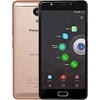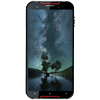Panasonic Eluga Ray Max vs Cubot Quest Lite
Quelle est la différence entre Panasonic Eluga Ray Max et Cubot Quest Lite. Découvrez quel smartphone offre les meilleures performances.
Performance (Benchmarks)
| 292 | 3DMark for Android Sling Shot Extreme (OpenGL ES 3.1 / Metal) | 273 |
Caractéristiques
| Panasonic Eluga Ray Max | Nom du produit | Cubot Quest Lite |
| Android 6.0 | Système d'exploitation (OS) | Android 9.0 |
| Bluetooth WLAN | Réseaux sans fil | Bluetooth WLAN |
| Yes, microUSB 2.0 | Interfaces / connecteurs | Yes, Type-C |
Ecran
| 1920 × 1080 px | Résolution d'écran | 1280 × 720 px |
| IPS LCD | Type d’écran | TFT LCD |
| Yes | Multipoints (multitouch) capacitif | Yes |
| 5.2" | Taille écran | 5" |
Processeur (CPU)
| Up to 1.4 GHz quad-core ARM Cortex-A53 and 1.1 GHz quad-core ARM Cortex-A53 | Architecture CPU | Up to 2.0 GHz quad-core ARM Cortex-A53 |
| Snapdragon 430 (MSM8937) | Processeur | Helio A22 |
| Adreno 505 | GPU | PowerVR GE8300 |
Mémoire
| 4096 MB | Mémoire RAM | 3072 MB |
| 32 / 64 GB | Capacité de stockage (ROM) | 32 GB |
| microSD / microSDHC / microSDXC | Carte mémoire | microSD |
Appareil photo
| Yes, 16 MP | Capteur photo | Yes, 13 MP |
| Yes, 8 MP | Capteur photo avant | Yes, 8 MP |
Communication
| GSM 850 / 900 / 1800 / 1900 | 2G | GSM 850 / 900 / 1800 / 1900 |
| HSDPA 900 / 2100 | 3G | HSDPA 900 / 2100 |
| LTE 850 / 1800 / 2300 | 4G (LTE) | LTE 800 / 900 / 1800 / 2100 / 2600 |
Géolocalisation
| Yes | GPS | Yes |
| Yes | A-GPS | Yes |
Batterie
| 3000 mAh | Capacite de la batterie | 3000 mAh |
Design
| 73 / 148 / 9.5 mm | Dimensions | 74 / 152 / 8.8 mm |
| 165 g | Poids | g |

